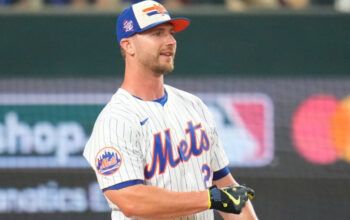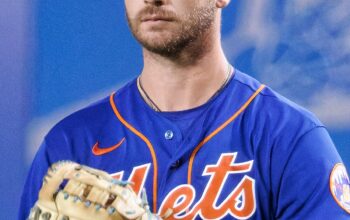NEW YORK When talking about how his bullpen strategies change throughout a nine-inning game on Wednesday, Carlos Mendoza laughed at the notion of creating a pregame strategy and following it.
“I don’t know that there’s ever a time you come up with a game plan and stick to it,” the Mets manager said. “Every time you make an adjustment because the game unfolds. … You have an idea, but then you have to make adjustments.”
Maybe David Stearns, Mendoza’s employer, should apply that advise to this season.
The Mets had a well-defined strategy going into 2024, from ownership all the way down to the clubhouse. They did not have the same lofty expectations as in prior spring training sessions, but they still believed they could push for the postseason and maintain a long window of opportunity going forward. And now here they are, days before the trade deadline, as respectable postseason candidates who have extended their window of contention for the future.
But perhaps it is time for Stearns and the New York front office to get a bit hungry about 2024 after another unforgettable victory on Thursday night—a walk-off 3-2 triumph over Atlanta that seemed to be the opposite of so many nightmare evenings at Turner Field. Indeed, the Mets will make a trade at the deadline. Let us argue, though, that the Mets should do more than just acquire a reliever in the upcoming week. The Mets should be aggressive buyers, just as they were when they last went on an unexpected pennant run in 2015.
The Mets are good enough
On the morning of July 26, let us conduct some blind resume exercises for teams over the years.
Blind resumes
| Team | W | L | Pct. | RD | NL Rank | GB of Playoffs |
|---|---|---|---|---|---|---|
| A | 56 | 46 | 0.549 | 85 | 5 | — |
| B | 55 | 47 | 0.539 | 9 | T5 | — |
| C | 55 | 47 | 0.539 | 49 | T3 | — |
| D | 54 | 48 | 0.529 | 23 | 5 | — |
| E | 50 | 46 | 0.521 | 46 | 7 | 0.5 |
| F | 48 | 51 | 0.485 | 36 | 10 | 6 |
OK, blindfolds off! What do those pretty similar teams all have in common? They all won the pennant.
NL pennant-winners (plus the Mets)
| Team | W | L | Pct. | RD | NL Rank | GB of Playoffs |
|---|---|---|---|---|---|---|
| 56 | 46 | 0.549 | 85 | 5 | — | |
| 55 | 47 | 0.539 | 9 | T5 | — | |
| 55 | 47 | 0.539 | 49 | T3 | — | |
| 54 | 48 | 0.529 | 23 | 5 | — | |
| 50 | 46 | 0.521 | 46 | 7 | 0.5 | |
| 48 | 51 | 0.485 | 36 | 10 | 6 |
At the trade deadline, they were also quite assertive. The 2018 Dodgers (Manny Machado) and the 2022 Phillies (David Robertson, Brandon Marsh, and Noah Syndergaard) are teams that gave up a lot of prospect resources in order to become All-in Buyers. Three relievers were added by the 2019 Nationals, one of whom would record the game’s last out. Atlanta acquired four outfielders in 2021, including the MVPs of the World Series and the NLCS. Arizona traded for a closer in 2023 in an effort to improve its postseason standing.
(For what it’s worth, the 2015 Mets, another All-in Buyer, were 50-48 with a negative-seven run differential on July 26.)
No, the Mets do not have the bullpen or rotation that you usually count on to save you in October. On the other hand, New York has an offense that seems playoff-ready. The Mets’ lineup can go deep with the best of them, as seen by their two-game thrashing of Gerrit Cole in the last month. Since the Mets began their hot streak on May 30, only Baltimore has hit more home runs. They are currently tied for fourth place in the majors in terms of home runs this season, ahead of all teams in the National League save the Dodgers. Francisco Lindor turned a single mistake by Chris Sale into two Mets runs, and it put New York in the game against a dominant Sale on Thursday.
By October, homers have committed infractions. In 2022, the offense with a comparable output but a different composition tied for 15th place in the league in terms of home runs. However, it was outperformed by Atlanta and San Diego in the season’s key games. With its power, this Mets attack can swing a quick series.
The National League is open
A word of caution: I would most likely make the same argument if I covered the Pirates, Reds, Padres, or Diamondbacks. because it is the most open National League in years.
For the past few seasons, Los Angeles and Atlanta have been the top two teams on the senior circuit. Both are going through typical seasons that are more volatile than usual. The Dodgers’ rotational health remains a concern, which ultimately led to their demise in October of last year. The best pitcher and hitter in Atlanta are gone for the season. Its lineup appears to be a shell of the team the Mets are accustomed to seeing.
Although the Phillies have assumed the role of the NL’s team to beat, the Mets are actually rather adept at defeating them. They notably defeated Philadelphia 14-5 in 2022 and even 6-7 in a losing 2023 season. The Mets are 2-4 against the Phillies this season. Surprisingly, New York is 10-3 against Aaron Nola or Zack Wheeler since the 2022 season began.
The timing actually clicks
Teams are very tempted to try to manipulate their window of contention, therefore this year they need exercise caution to avoid putting too many eggs in one basket too soon. But in doing so, they frequently lose out on the year to win.
The Mets in 2015 could have exercised greater caution: Given that Wheeler was down, Syndergaard and Steven Matz were inexperienced, and the NL had multiple elite clubs, the Mets’ greatest chance of making the postseason in October had to be further away, right? In the end, the Mets’ aggression paid off with a pennant, as that youthful rotation was never as healthy or as dominant as it was at that precise moment.
Compare that to the Pirates of 2013–2015, who never took the decisive action to elevate a very strong squad. Since 1979, they have yet to win a postseason series.)
It is also reasonable to wonder about the Mets: Specifically, which year are they holding out for? Due to injuries to several important prospects this season, New York will not be preparing for spring training 2025 with the intention of giving a gifted rookie a regular spot. Guys like Lindor, who will be 32, and Brandon Nimmo, who will be 33, will not be fully included until 2026. By then, Jett Williams, Drew Gilbert, Luisangel Acuña, and Ryan Clifford will already be past their prime.
Opening a prolonged window of contention and seizing justifiable chances to win divisions, pennants, and championships are the objectives. There are the Mets. These are career-best years for the two players they inked long-term contracts with. It is possible that their star first baseman will not be here next season.
The window of contention is already open.
What does this mean?
To be honest, most columns like these stop here. After providing all the justification for taking a chance, it is up to Stearns to make it happen.
However, I would be negligent if I did not point out that it is challenging to pursue given the current state of the deadline market. In the National League, teams like the Pirates, Reds, Padres, and Diamondbacks are still competitive, and there are fewer sellers than normal. This season, the best starter who is most likely to be moved might not be able to start very often. You would not be able to confidently hit on the walk rate of the top reliever who is most likely to be moved in blackjack.
The difficulty of projecting acquisition costs in trades is significantly greater than that of open-market salary, which makes it more challenging to create the kind of plan that I do for the offseason. I will thus settle with recommendations that are more in line with an all-in strategy.
1. With Garrett Crochet, engage the White Sox with the knowledge that you will be obtaining him to close games in 2024. According to a story published in The Athletic on Thursday, unless he signs a contract extension with an acquisition team, Crochet would prefer to continue playing as a starter for the remainder of this season, although with less innings.
A long-term ace would be useful for the Mets, as I mentioned Thursday morning. This is a left-handed All-Star, 25, who leads the league in strikeouts and would like to sign a long-term contract. All of those seem like positive things. Similar to Wheeler, Crochet’s lack of availability during his career thus far will likely limit his arbitration salary for the following two seasons. Hence, compared to the luxury tax, a lengthy extension would be less expensive.)
Buy Crochet, give him a contract extension, and use him as a multi-inning reliever with scheduled appearances for the remainder of the season. Imagine him entering the postseason as a one-man bridge to Edwin Díaz, coming in behind your right-handed starters. Reintroduce him into the lineup for 2025 and beyond. That might be worth the hefty package of prospects needed because it would spare the Mets from having to pay a premium price for a starting pitcher who is already in his 30s this winter.
2. If Crochet proves to be too much, add two players to the pen and one to the bench along with a pitcher who misses more bats than the current starters to improve the rotation.
Yusei Kikuchi of Toronto and Jack Flaherty of Detroit sprang to mind as members of the rotation. Although Flaherty will come at a significant cost, he too could be able to return.
Priority should be given to one lefty with significant leverage in the bullpen. Navigate beyond Tanner Scott to Andrew Nardi, his colleague, or Andrew Chafin of the Tigers, who has been The Athletic’s longtime objective. Adding another multi-inning arm could also assist maintain the group’s freshness. Alex Faedo of Detroit or Buck Farmer of Cincinnati could be employed there.
The last addition would be a flexible bench player who could shield the Mets from injury or regress at several different spots. Andy Ibañez of Detroit, Amed Rosario of Tampa Bay, Isiah Kiner-Falefa of Toronto, and Abraham Toro of Oakland are candidates for the position.
(Photo of José Buttó: Adam Hunger / Getty Images)


